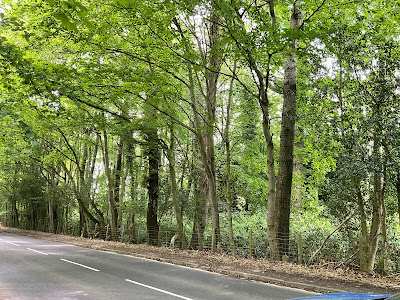When I travelled to Newlandrig, on the day I came down with Covid, I was probably missing the subtle clues about the landscape and the built environment. Helen was driving me around the locations associated with Robert Buchan b1813. Most of these places are significant for many other Buchan descendants.
The Buchans were in Newlandrig by 1808, when an infant son died and was buried in Newbattle Churchyard. They were there in the 1921 census, barely. We drove along the Dalkeith Bypass (A68) to turn off onto Main St (B6372). Soon after the turnoff was Dewarton, and I really can't remember it, where the Buchans lived from about 1800-1804.
Newlandrig is half way between Pathead and Gorebridge. It is about 10 minutes drive from Dalkeith, and perhaps 20 minutes from Edinburgh by car. Being tucked in the middle of a rural landscape, only a minor road passes anywhere near it. However it is a pretty place, with wide open fields on either side, and patches of dense trees that evoke mystery, intrigue and shady-ness!
Like many Scottish hamlets and villages built anywhere from 1700-early 1800s, houses are arrayed on each side of an existing road (or track). It is likely that Newlandrig began this way along a track between Gorebridge and Pathead. Rev Cluney notes in 1790 that Newlandrig is one of the ancient villages, and I believe this as you'll see below.
In 1841 it had about 20 dwellings which were arranged along this same 'modern' road. In 2024 there were still about the same 20 dwellings placed along each side of the road. Farmland stretched out on either side.
Lets enter it.
 |
| Welcome to Newlandrig, I walked carefully! |
But nothing beats walking along each side of the street, peering closely at details on the houses and then stepping back for a wider vista.
And there are locals to talk to; well there was one local resident weeding her front garden. We did speak though.
 |
| Greenness abounds |
But it is the variety of small scale architecture which is so appealing: Oh why was I coming down with Covid when I could have knocked on so many doors - 'The Old School House' in the image bottom right above, and some of the clearly more ancient dwellings. But all seem to have been re-roofed, modern windows installed and a general air of comfort was obvious. How different it might have been 200 years ago.
 |
| A range of dwellings of the 20 or so buildings |
The entire village was owned by David McKinlay of 25 Royal Terrace, Edinburgh in 1855. Oddly enough the village of Newlandrig in 1841 was called Newlandburn in the 1851 census, and in 1855 it was known as 'Newlandtown'. The name then reverts to Newlandrig thereafter. This threw me for a while before realising that they all referred to the same place.












